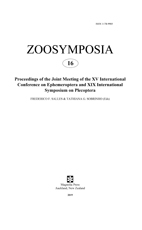Abstract
This study was presented at the International Conference on Ephemeroptera and Plecoptera held in Aracruz, Brazil from June 3–8, 2018. Higher-level relationships among major mayfly lineages remains controversial and previous molecular and morphological data do not robustly support the current classification scheme and many of the proposed branching orders (Ogden et al. 2009a). This project represents the largest phylogenetic analysis for mayflies to date. Over 440 targeted genomic protein coding regions (exons) were generated using a novel hybrid enrichment probes set. The dataset, analyzed as amino acids, allowed testing for the monophyly of many of the proposed higher-level groupings. The results from this work were congruent with the lineages Carapacea, Caenoidea, and Ephemerelloidea, but the other higher-level lineages were not supported as monophyletic. This study was an initial evaluation of the anchored hybrid enrichment dataset for uses in deep level mayfly systematics, and a more comprehensive analysis is forthcoming. Still, this study supports the conclusion that more taxa and data, especially phylogenomic data, should result in more robust trees for future studies in mayfly phylogenetics and systematics.

